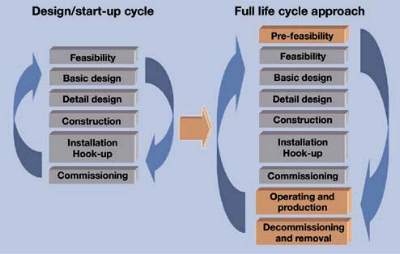ITALY: An engineering approach to operation and maintenance
April 2001 Vol. 222 No. 4 Feature Article ITALY: An engineering approach to operation and maintenance During the last decade, optimizing oil and gas plant
ITALY:An engineering approach to operation and maintenanceDuring the last decade, optimizing oil and gas plant performance has been crucial to reduce operative costs, improve safety and minimize environmental impact. In addition, the reduction of operating personnel has stimulated identification of new approaches for managing operation and maintenance activities. Ten years ago, Italy’s Tecnomare, a design and engineering services company for international E&P firms since 1971, extended its services to the operation of oil and gas production systems. Such services were mainly related to maintenance aspects of offshore systems, for both structures and equipment. Since the beginning, it appeared that the engineering experience of a company able to perform services such as design, procurement, project management, field supervision and commissioning, could be beneficial to improving plant availability and rationalizing maintenance activities. Further, the typical exchange of information that happens inside an engineering company could be applied to the life cycle of a production system, thus securing the optimization and balance of Capex and Opex costs of new-field developments. This approach has been called a "life-cycle approach" and is based on several key factors. First is the integration between engineering and operation teams starting at the design phase. Second is use of historical maintenance data from similar plants to optimize new plant designs. Next is the preparation of a maintenance / inspection plan beginning with the design phase, which also impacts materials selection, equipment selection and instrumentation. Finally, the maintenance requirements are determined by the criticality definition for the spares / replacement policy, in keeping with the maintenance reference plan. In the following, three cases serve as an example of the aforementioned approach.
Global Maintenance Service (GMS). The company is currently providing GMS for Eni / Agip for 23 offshore plants located in the Adriatic Sea, more specifically, for maintenance engineering and project management. A full, life-cycle approach methodology is being implemented throughout the following services: maintenance-policy review; reliability, availability, maintainability and safety analysis; feedback from the field; plants revamping; and management and supervision of maintenance execution. Based on previous results, a proposal was developed to optimize the maintenance policy and revamp intervention on part of the plants, to improve the overall efficiency. In particular, a risk-based inspection approach was proposed to reduce maintenance frequency, with the final target of adopting an on-condition maintenance policy instead of preventive maintenance. The proposed policy may lead to a reduction of up to 30% of costs and about a 1% increase in annual production. The good performance can be credited to the following key factors: integration with the production operator; engineering know-how about structures, plant design and operation; and use of advanced tools to focus maintenance on up-time improvement and cost reduction. Underwater inspection / platform reassessment. The company has performed, together with Eni / Agip, a reassessment of underwater-inspection to define new criteria for planning, and to produce new specifications concerning all offshore Italy platforms. The main objective was to develop innovative approaches to achieve cost-effective solutions without reducing facility safety levels. The engineering work started from a global review of the original inspection schedule and extended that to remaining installation life. The new approach was based on environmental data and reliability reassessment analysis of the offshore structures in operating conditions. The target was a reduction of both the number of critical elements inspected and the relevant survey frequency, without compromising the overall structural safety. Specific reliability target values were selected for the critical components as a function of their structural importance and risk class. The ranking of critical structural elements allowed adoption of a floating-member detection-examination method to check the less important elements, in substitution of the more expensive magnetic particle inspection methods. The data collected from offshore recordings has increased the fatigue life of several platforms. Consequently, re-planning of underwater inspections led to nearly a 50% decrease in inspection costs. Implementing the CMMS. The need to manage a
large amount of maintenance data has led to the development of an integrated Computerized Maintenance
Management System (CMMS), based on customization of commercially available tools. CMMS has been finalized for
the following services: survey, data collection and plant breakdown; main equipment-list preparation;
plant-criticality analysis; maintenance-policy development; definition of preventive-maintenance work cycle;
and bills of material. CMMS has been implemented and tested on 141 offshore and onshore plants, both for
Italian and Egyptian fields operated by Eni / Agip.
|



